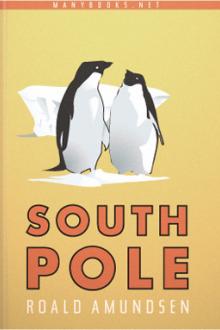The North Pole by Robert E. Peary (room on the broom read aloud .TXT) 📕

- Author: Robert E. Peary
- Performer: -
Book online «The North Pole by Robert E. Peary (room on the broom read aloud .TXT) 📕». Author Robert E. Peary
I have been studying the Eskimos for eighteen years and no more effective instruments for arctic work could be imagined than these plump, bronze-skinned, keen-eyed and black-maned children of nature. Their very limitations are their most valuable endowments for the purposes of arctic work. I have a sincere interest in these people, aside from their usefulness to me; and my plan from the beginning has been to give them such aid and instruction as would fit them more effectively to cope with their own austere environment, and to refrain from teaching them anything which would tend to weaken their self-confidence or to make them discontented with their lot.
The suggestions of some well-meaning persons that they be transported to a more hospitable region would, if carried out, cause their extermination in two or three generations. Our variable climate they could not endure, as they are keenly susceptible to pulmonary and bronchial affections. Our civilization, too, would only soften and corrupt them, as their racial inheritance is one of physical hardship; while to our complex environment they could not adjust themselves without losing the very childlike qualities which constitute their chief virtues. To Christianize them would be quite impossible; but the cardinal graces of faith, hope, and charity they seem to have already, for without them they could never survive the six-months' night and the many rigors of their home.
Their feeling for me is a blending of gratitude and confidence. To understand what my gifts have meant to them, imagine a philanthropic millionaire descending upon an American country town and offering every man there a brownstone mansion and an unlimited bank account. But even this comparison falls short of the reality, for in the United States even the poorest boy knows that there is a possibility of his attaining for himself those things on which he sets his heart, if he will labor and endure, while to the Eskimos the things which I have given them are absolutely out of their world, as far beyond their own unaided efforts as the moon and Mars are beyond the dwellers on this planet.
My various expeditions into that region have had the effect of raising the Eskimos from the most abject destitution, lacking every appliance and accessory of civilized life, to a position of relative affluence, with the best material for their weapons, their harpoons and lances, the best of wood for their sledges, the best of cutlery, knives, hatchets, and saws for their work, and the cooking utensils of civilization. Formerly they were dependent upon the most primitive hunting weapons; now they have repeating rifles, breech-loading shotguns, and an abundance of ammunition. There was not a rifle in the tribe when I first went there. As they have no vegetables, and live solely on meat, blood, and blubber, the possession of guns and ammunition has increased the food-producing capacity of every hunter, and relieved the whole tribe from the formerly ever-present danger of starvation for a family, or even an entire village.
There is a theory, first advanced by Sir Clements Markham, ex-president of the Royal Geographical Society of London, that the Eskimos are the remnants of an ancient Siberian tribe, the Onkilon; that the last members of this tribe were driven out on the Arctic Ocean by the fierce waves of Tartar invasion in the Middle Ages, and that they found their way to the New Siberian Islands, thence eastward over lands yet undiscovered to Grinnell Land and Greenland. I am inclined to believe in the truth of this theory for the following reasons:
Some of the Eskimos are of a distinctly Mongolian type, and they display many Oriental characteristics, such as mimicry, ingenuity, and patience in mechanical duplication. There is a strong resemblance between their stone houses and the ruins of the houses found in Siberia. The Eskimo girl brought home by Mrs. Peary, in 1894, was mistaken by Chinamen for one of their own people. It has also been suggested that their invocation of the spirits of their dead may be a survival of Asian ancestor worship.
As a general rule the Eskimos are short in stature, as are the Chinese and Japanese, though I could name several men who stand about five feet ten inches. The women are short and plump. They all have powerful torsos, but their legs are rather slender. The muscular development of the men is astonishing, though their fatty roundness hides the differentiation of the muscles.
These people have no written speech, and their language is agglutinative, with complicated prefixes and suffixes, by which they extend a word to a considerable length from the original stem. The language is relatively easy to acquire, and during my first summer in Greenland I gained a fair knowledge of it. In addition to their ordinary speech, they have an esoteric language known only to the adults of the tribe. I cannot say wherein it differs from the other, having made no attempt to learn it, and I doubt if any white man has been fully taught this secret speech, as the knowledge is carefully guarded by its possessors.
The Eskimos of this region have not, as a rule, applied themselves to the study of English, for they were clever enough to see that we could learn their language more easily than they could learn ours. Occasionally, however, an Eskimo will startle all hands by rolling out an English phrase or sentence, and, like a parrot, he seems to have a special aptitude in picking up from the sailors phrases of slang or profanity.
On the whole, these people are much like children, and should be treated as such. They are easily elated, easily discouraged. They delight in playing tricks on each other and on the sailors, are usually good-natured, and when they are sulky there is no profit in being vexed with them. The methods which children characterize as "jollying" are best for such emergencies. Their mercurial temperament is Nature's provision for carrying them through the long dark night, for if they were morose like the North American Indians, the whole tribe would long ago have lain down and died of discouragement, so rigorous is their lot.
In managing the Eskimos it is necessary to make a psychological study of them, and to consider their peculiar temperament. They are keenly appreciative of kindness, but, like children, they will impose upon a weak or vacillating person. A blending of gentleness and firmness is the only effective method. The fundamental point in all my dealings with them has been always to mean just what I say and to have things done exactly as ordered. For instance, if I tell an Eskimo that if he does a certain thing properly he will get a certain reward, he always gets the reward if he obeys. On the other hand, if I tell him that a certain undesirable thing will happen if he follows a course I have forbidden, that thing invariably happens.
I have made it to their interest to do what I want done. For example, the best all-round man on a long sledge journey got more than the others. A record was always kept of the game secured by each Eskimo, and the best hunter got a special prize. Thus I kept them interested in their work. The man who killed the musk ox with the finest set of horns and the man who killed the deer with the most magnificent antlers were specially rewarded. I have made it a point to be firm with them, but to rule them by love and gratitude rather than by fear and threats. An Eskimo, like an Indian, never forgets a broken promise—nor a fulfilled one.
It would be misleading to infer that almost any man who went to the Eskimos with gifts could obtain from them the kind of service they have given me; for it must be remembered that they have known me personally for nearly twenty years. I have saved whole villages from starvation, and the children are taught by their parents that if they grow up and become good hunters or good seamstresses, as the case may be, "Pearyaksoah" will reward them sometime in the not too distant future. Old Ikwah, for example, who is the father of the girl for whose possession hot-hearted young Ooqueah of my North Pole party fought his way with me to the goal, was the first Eskimo I had, away back in 1891.
This young knight of the Northland is an illustration of the fact that sometimes an Eskimo man or woman may be as intense in his or her affairs of the heart as we are. As a rule, however, they are more like children in their affections, faithful to their mates from a sort of domestic habit, but easily consoled for the loss of them by death or otherwise.
In a little arctic oasis lives the meager and scattered handful of the Eskimo population—a little oasis along the frowning western coast of Northern Greenland between Melville Bay and Kane Basin. This region is three thousand miles north of New York City, as a steamer goes; it lies about half way between the Arctic Circle and the Pole, within the confines of the great night. Here, taking the mean latitude, for one hundred and ten days in summer the sun never sets; for one hundred and ten days in winter the sun never rises, and no ray of light save from the icy stars and the dead moon falls on the frozen landscape.
THE ICE CLIFFS OF HUBBARD GLACIER
There is a savage grandeur in this coast, carved by eternal conflict with storms and glaciers, bergs and grinding ice-fields; but behind the frowning outer mask nestle in summer many grass-carpeted, flower-sprinkled, sun-kissed nooks. Millions of little auks breed along this shore. Between the towering cliffs are glaciers which launch at intervals their fleets of bergs upon the sea; before these cliffs lies the blue water dotted with masses of glistening ice of all shapes and sizes; behind the cliffs is the great Greenland ice cap, silent, eternal, immeasurable—the abode, say the Eskimos, of evil spirits and the souls of the unhappy dead.
In some places on this coast in summer, the grass is as thick and long as on a New England farm. Here bloom poppies, with dandelions, buttercups, and saxifrage, though to the best of my knowledge the flowers are all devoid of perfume. I have seen bumblebees even north of Whale Sound; there are flies and mosquitoes, and even a few spiders. Among the fauna of this country are the reindeer (the Greenland caribou), the fox—both blue and white—the arctic hare, the Polar bear, and perhaps once in a generation a stray wolf.
But in the long sunless winter this whole region—cliffs, ocean, glaciers—is covered with a pall of snow that shows a ghastly gray in the wan starlight. When the stars are hidden, all is black, void, and soundless. When the wind is blowing, if a man ventures out he seems to be pushed backward by the hands of an invisible enemy, while a vague, unnamable menace lurks before and behind him. It is small wonder the Eskimos believe that evil spirits walk upon the wind.
During the winter these patient and cheerful children of the North live in igloos, or huts, built of stones and earth. It is only when they are traveling, as sometimes during the moonlit period of the month, that they live in the snow igloos, which three good Eskimos can build in an hour or two, and which we built at the





Comments (0)